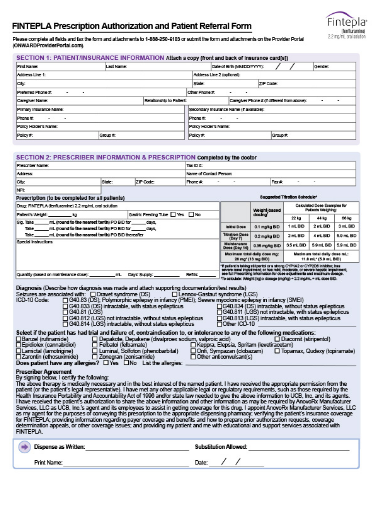Resources for prescribers
Resources for healthcare providers (HCPs) who are ready to prescribe FINTEPLA
The following resources can be used to provide you and your office with key information on prescribing FINTEPLA.
Are you looking for resources to share with your patients’ caregivers?
Dosing FINTEPLA
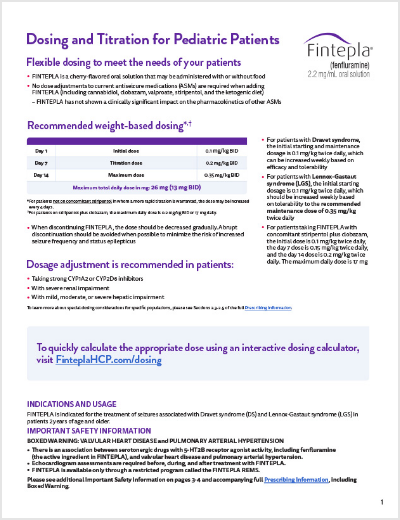
FINTEPLA Dosing and Titration Flashcard
Provides prescribers with the recommended starting doses and titration schedules for FINTEPLA
About echocardiograms
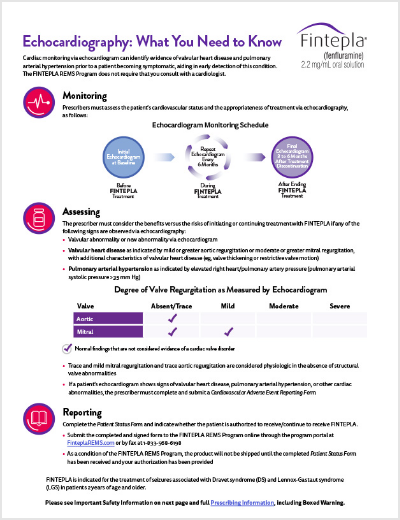
Echocardiography: What You Need to Know
Provides prescribers with an overview of the REMS-required monitoring with echocardiograms for patients taking FINTEPLA
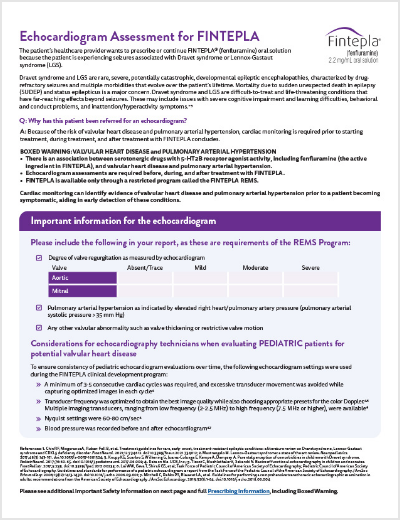
Echocardiogram Assessment Sheet
Provides cardiologists and echocardiography technicians with information on monitoring for FINTEPLA patients
ONWARD™ is here for you and your staff.
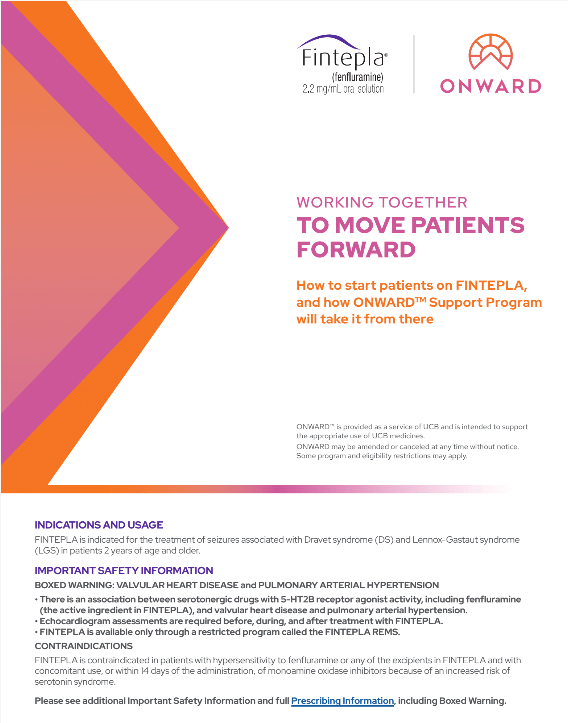
Prescribing FINTEPLA
Provides prescribers with an overview of getting patients started on FINTEPLA

ONWARD Backgrounder for Prescribers
Provides prescribers with a brief overview of how ONWARD can guide their staff and caregivers
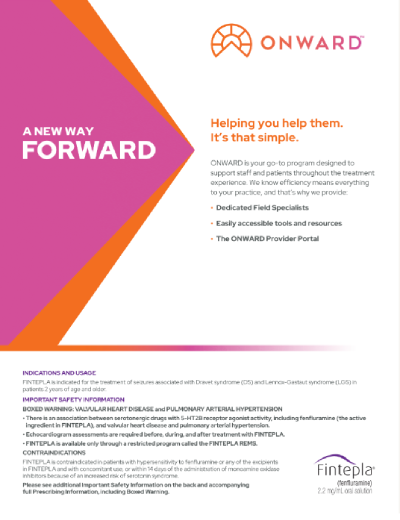
ONWARD Backgrounder for Office Staff
Provides details on support for the office staff, including dedicated Field Specialists, accessible resources, and the ONWARD Provider Portal
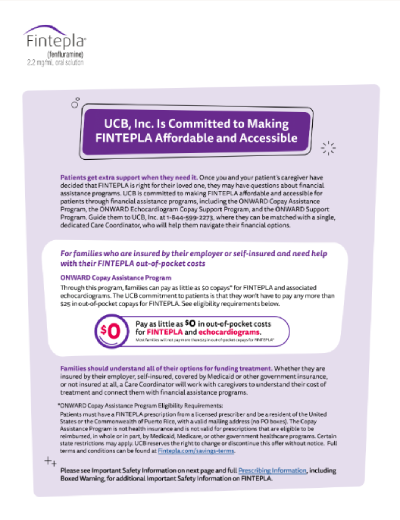
Financial Assistance and Copay Info for HCPs
Provides an overview of the financial assistance programs available for FINTEPLA and associated echocardiograms
Learn from your peers who have experience treating patients with FINTEPLA.
James Wheless, MD
Shares Dravet syndrome clinical trial data and a patient case from his practice
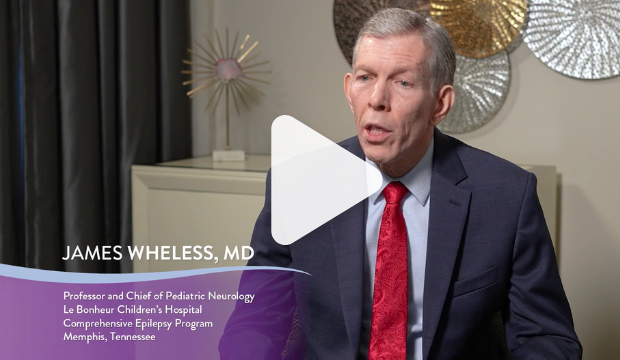
Steven Wolf, MD
Shares information about the impact of Dravet syndrome and critical considerations for optimizing seizure treatment

James Wheless, MD
Shares cardiovascular safety data and his clinical experience treating patients with FINTEPLA

Steven Wolf, MD
Shares best practices regarding cardiovascular monitoring for patients taking FINTEPLA

Scott Perry, MD, and
Kelly Knupp, MD
Discuss challenges in treating Dravet syndrome
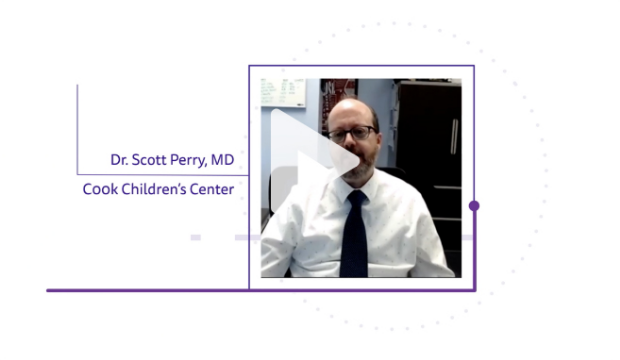
Important contact information
FINTEPLA REMS
For more information about the FINTEPLA REMS, or to access FDA-mandated REMS forms, please call 1-877-964-3649 or visit FinteplaREMS.com.
FINTEPLA prescriptions
If you have questions about a patient’s prescription or about refills, contact AnovoRx at 1-844-288-5007 (8:00 AM to 5:00 PM Central Time, Monday through Friday) or send a fax to 1-855-813-2039.
ONWARD
To learn more about financial assistance programs and their eligibility criteria, call ONWARD at 1-888-964-3649.
Frequently asked questions1
FINTEPLA is indicated for the treatment of seizures associated with Dravet syndrome and Lennox-Gastaut syndrome (LGS) in patients 2 years of age and older.
In the randomized, double-blind, placebo-controlled trials of FINTEPLA in Dravet syndrome, convulsive seizure types assessed included tonic, clonic, generalized tonic-clonic (GTC), tonic-atonic, secondarily GTC, hemiclonic, and focal with observable motor signs.
In the randomized, double-blind, placebo-controlled trial of FINTEPLA in LGS, the primary endpoint was the change in frequency of the following seizure types that were confirmed by The Epilepsy Study Consortium to have resulted in a drop, fall, or injury: generalized tonic-clonic (GTC), secondarily GTC, tonic, atonic, and tonic-atonic.
Patients on a ketogenic diet were included in the clinical studies. FINTEPLA is compatible with a ketogenic diet and contains no ingredient made from gluten-containing grain (wheat, barley, or rye) and not more than 0.1% of carbohydrates, which is solely derived from the cherry flavor.
Most patients do not need to have a cardiology consultation in order to get an echocardiogram, which can be ordered as a screening test, just like other screening procedures. However, certain epilepsy centers require that an epileptologist refer a patient to a cardiologist in order to get an echocardiogram.
UCB is committed to making FINTEPLA affordable and accessible for patients through financial assistance programs. Patients may pay as little as $0 in out-of-pocket costs for FINTEPLA and echocardiograms. Most families will not pay more than $25 in out-of-pocket copays for FINTEPLA.* For more information about these financial assistance programs, including eligibility criteria, call 1-833-GO-DS-LGS (1-833-463-7547).
*Subject to eligibility; individual out-of-pocket costs may vary. See full Terms and Conditions.
UCB strives to make the FINTEPLA Risk Evaluation and Mitigation Strategy (REMS) as accessible as possible. That’s why UCB has established a network of sonographers who can travel directly to eligible patients who are unable to access an echocardiogram (echo) facility due to their geographic location or disease-related limitations. Full eligibility Terms and Conditions apply.*
*Eligibility Terms and Conditions: The At-home Echo Program is intended to assist certain eligible patients who have been prescribed FINTEPLA to obtain an echocardiogram assessment in accordance with the product labeling and the FINTEPLA REMS, as required by the US Food and Drug Administration. To be eligible for the program, a patient (or their caregiver) must attest that they are unable to safely access a qualified healthcare provider’s office for an echocardiogram due to their geographic location or disease-related limitations. Participating patients, caregivers, and/or healthcare providers may not submit any claims for reimbursement to any third-party payer for echocardiograms provided through the program. The program may be amended or canceled at any time without notice.
![]()
Ready to get patients started on FINTEPLA?
By completing and submitting this form, you can provide the first prescription and enroll the patient in ONWARD.
![]()
Connect with your Key Account Manager
Your Key Account Manager is available to provide additional information and answer questions.
Reference
1. FINTEPLA (fenfluramine) oral solution: U.S. prescribing information. Smyrna, GA: UCB, Inc.


